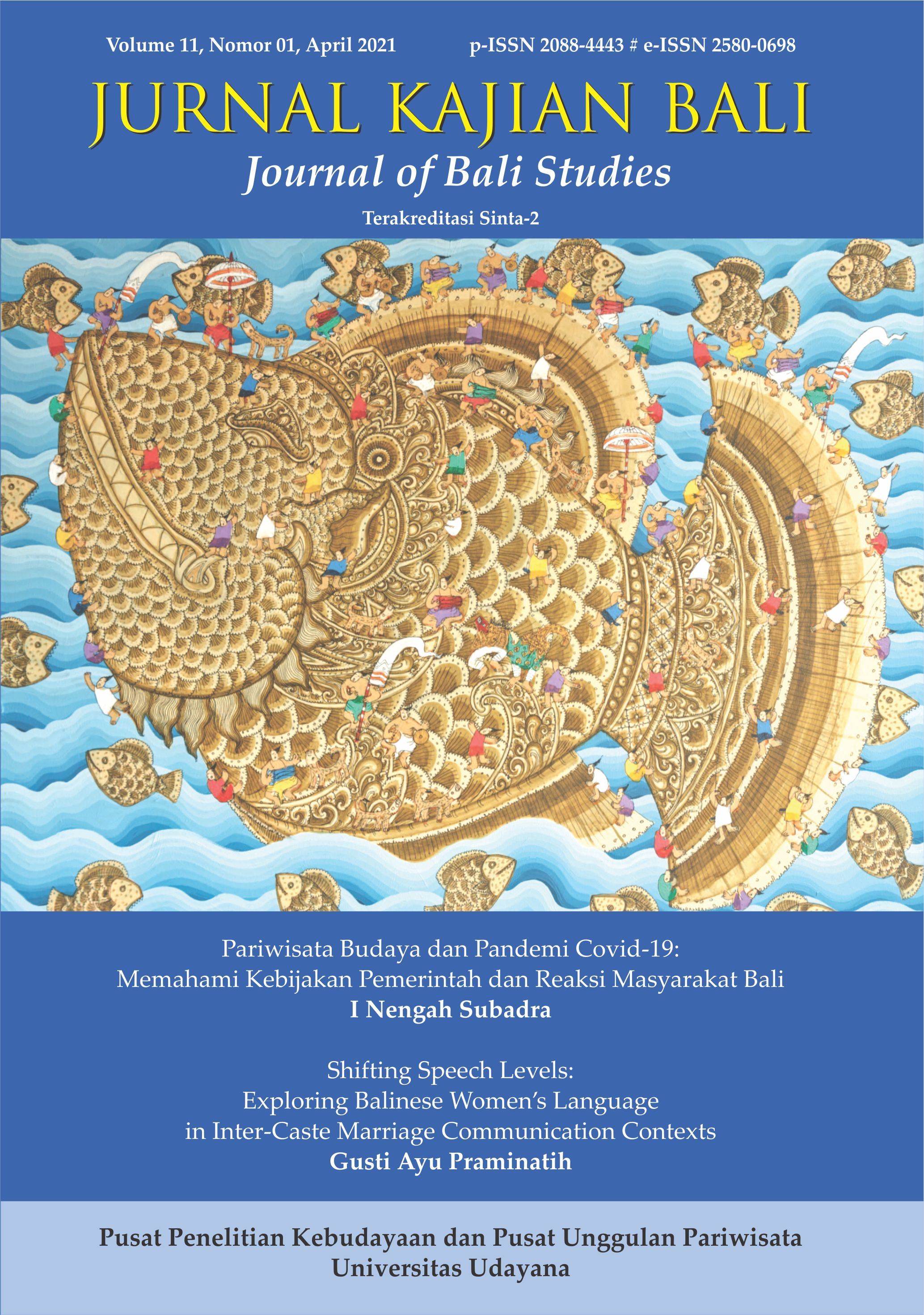An Ethnolinguistic Perspective on Lexicons of Traditional House in Menyali Village, North Bali
Abstract
This study aims at identifying the concepts and the lexicons of traditional Balinese houses in Menyali Village, Sawan District, Buleleng Regency. This study is a descriptive qualitative research that involved three respondents, who were selected purposively. The data were collected through interviews and observation and analyzed using an interactive data analysis model. This study found that the Menyali community views that the tri mandala concept underlines its traditional house's spatial pattern. It includes nista (the profane lying), madya (middle lying for living area), and utama (the highest and holiest lying). It is also spiritually connected to two spiritual concepts, kangin-kauh (the directional axis of sunrise and sunset) and kaje-kelod (the directional axis of mountain and sea). This study identified 24 lexicons connected to the utama mandala, 7 to the madya mandala, and 5 to the nista mandala. The lexicon number is influenced by the area function and the rituals held in those areas.
Downloads
References
Bird, S. (2010). A scalable method for preserving oralliterature from small languages. Dalam G. Chowdhury, C. Koo, & J. Hunter (Penyunt.), The Role of Digital Libraries in a Time of Global Change. ICADL 2010. Lecture Notes in Computer Science (Vol. 6102, hal. 5-14). Berlin: Springer. doi:https://doi.org/10.1007/978-3-642-13654-2_2
Bussmann, H. (2006). Routledge dictionary of language . London: Routledge.
Canavan, B. (2016). Tourism culture: Nexus, characteristics, context and sustainability. Tourism Management, 53, 229-243. doi:https://doi.org/10.1016/j.tourman.2015.10.002
Crowly, T. (1997). Introduction to Historical Linguistics. New York: Oxford University Press.
Duranti, A. (2009). Linguistic anthropology: History, ideas, and issues. Dalam A. Duranti (Penyunt.), Linguistic anthropology: A reader (2nd ed.). West Sussex: Blackwell Publishing.
Foley, W. A. (2001). Anthropological linguistics: An Introduction. Massachusetts: Blackwell Publishing.
Grenoble, L. A., & Whaley, L. J. (2006). Saving languages: An introduction to language revitalization. Cambridge: Cambridge University Press.
Hani, U., Azzadina, I., Sianipar, C. P., Setyagung, E. H., & Ishii, T. (2012). Preserving cultural heritage through creative industry: A lesson from Saung Angklung Udjo. Procedia Economics and Finance, 4, 193 – 200. doi: 10.1016/S2212-5671(12)00334-6
Hassani, F. (2015). Documentation of cultural heritage techniques, potentials and constraints. The International Archives of the Photogrammetry, Remote Sensing and Spatial Information Sciences, 15(5), 207-214. doi:10.5194/isprsarchives-XL-5-W7-207-2015
Johnson, K., & Johnson, H. (1999). Encyclopedic dictionary of applied linguistics : A handbook for language teaching. Oxford: Blackwell Publishing Ltd.
Kardana, I. N., Mahayana, I. M., & Rajistha, I. G. (2020). The dynamics of balinese lexicon in sanur tourism area: An ecolinguistic approach. International Linguistics Research, 3(4), 142-151. doi:https://doi.org/10.30560/ilr.v3n4p142
Kraisame, S. (2018). Language endangerment and community empowerment: Experience form community training in the Moken language documentation and preservation project. Kasetsart Journal of Social Sciences, 39(2), 244-253. doi:https://doi.org/10.1016/j.kjss.2017.05.002
Kramsch, C. (1998). Language and culture. Oxford: Oxford University Press.
Majzuba, R. M., & Rais, M. M. (2011). Perceptions of students and lecturers on the preservation of endangered languages. Procedia Social and Behavioral Sciences, 15, 1677–1683. doi:10.1016/j.sbspro.2011.03.351
Meinarni, N. P., Pande, N. K., Willdahlia, A. G., & Winatha, K. R. (2019). Legal Knowledge Development Plan in Responding Student’s Understanding on IT Law: “Pawongan” Approach. Advances in Social Science, Education and Humanities Research, 397, 1239-1247.
Miles, M. B., Huberman, A. M., & Saldana, J. (2014). Qualitative data analysis, a methods sourcebook. New York: Sage Publications.
Musgrave, S. (2014). Language shift and language maintenance in Indonesia. Dalam P. Sercombe, & R. Tupas (Penyunt.), Language, Education and Nation-building. Palgrave Studies in Minority Languages and Communities. (hal. 87-105). London: Palgrave Macmillan. doi:https://doi.org/10.1057/9781137455536_5
Ningsih, N. P., & Hidayah, R. (2019). Dualism of the Protected Areas (Holy Region) on the Purnama Beach, Gianyar - Bali. IOP Conf. Series: Earth and Environmental Science 3, 366, 1-8. doi:10.1088/1755-1315/366/1/012005
Perrault, N., Farrell, M. J., & Davies, T. J. (2017). Tongues on the EDGE: Language preservation priorities based on threatand lexical distinctiveness. Royal Society Open Science, 4, 1-10. doi:http://dx.doi.org/10.1098/rsos.17121
Priambada, A. F. (2011). Bentuk dan makna rumah adat kudus. Semarang: Universitas Negeri Semarang.
Priyoga, I. M., & Sudarwani, M. (2018). Kajian pola ruang dan rumah adat desa Penglipuran Bali.
Putri, I. G., & Santika, I. D. (2020). The Emotional Lexicon Used by Male and Female Communication: Study of Balinese Language Used in South Kuta-Bali. Linguistic, English Education and Art (LEEA) Journal, 3(2), 364-372. doi:https://doi.org/https://doi.org/10.31539/leea.v3i2.1177
Reny, E. K., Subroto, T. Y., & Saifullah, A. (2017). Konsep Ka’bani–Mawinne dalam Arsitektur Rumah Tradisional Sumba di Kampung Tarung Sumba Barat. Tesa Arsitektur, 16(2), 94-105.
Richards, J. C., & Schmidt, R. (2010). Longman Dictionary of Language Teaching and Applied Linguistics. Harlow: Longman.
Runa, I. W. (2018). Pembangunan berkelanjutan berdasarkan konsep Tri Hita Karana untuk kegiatan ekowisata. Jurnal Kajian Bali, 2(1), 149-162.
Siwalatri, N. K., Prijotomo, J., & Setijanti, P. (2015). Spatial Concepts of Bali Indigenous Architecture. Procedia - Social and Behavioral Sciences, 179, 118-127. doi:https://doi.org/10.1016/j.sbspro.2015.02.415
Sulatra, I. P. (2019). Verba lempar bahasa Bali: Kajian metabahasa semantik alami. SPHOTA: Jurnal Linguistik Dan Sastra, 11(2), 41-48. doi:https://doi.org/10.36733/%sphota.v11i2.1208
Suryasa, I. W. (2016). Ngalap in Balinese: A natural semantic metalanguage approach. Lingual: Journal of Language and Culture, 1(1), 1-9. doi:https://doi.org/10.24843/LJLC.2016.v01.i01.p07
Tsunoda, T. (2001). Language Endangerment. Dalam N. J. Smelser, & P. B. Baltes, International Encyclopedia of the Social & Behavioral Sciences (hal. 8349-8353). Oxford: Pergamon.
Wahana, N. P., Sari, S. M., & Rakhmawati, A. (2015). Wujud Ajaran Tri Hita Karana pada Interior Pura Agung Jagad Karana Surabaya. Intra, 3(2), 520-530.
Wamalwa, E. W., & Oluoch, S. B. (2013). Language endangerment and language maintenance: Can endangered indigenous of Kenya be electronically preserved? International Journal Humanities and Social Science, 3(7), 258-266.
Wijana, I. D., & Rohmadi, M. (2013). Sosiolinguistik: Kajian teori dan analisis. Jakarta: Pustaka pelajar.
Wijaya, K., & Wiranegara, H. (2020). Balinese planning philosophy: Implementation in Denpasar city plan. International Journal on Livable Space, 5(1), 11-20. doi:http://dx.doi.org/10.25105/livas.v5i1.6352
Yudantinia, N. M., & Jones, D. (2015). The Catuspatha pattern in Balinese palace: architectural conservation and challenges. Procedia Environmental Sciences, 28, 538-548. doi:10.1016/j.proenv.2015.07.064

This work is licensed under a Creative Commons Attribution 4.0 International License.



















